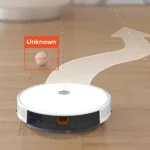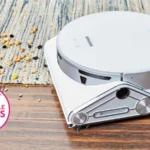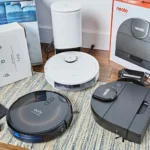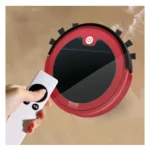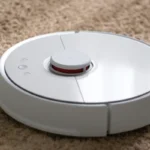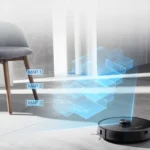Keeping our homes clean and organized is essential to maintaining a healthy and comfortable living space. And while vacuum cleaners have been a helpful tool for decades, they can be time-consuming and tedious to operate. However, with the advent of smart vacuum cleaners powered by navigation systems, cleaning our homes has become more efficient and effortless than ever before. In this article, we’ll explore how these innovative devices are revolutionizing home cleaning through mapping and pathfinding, adaptability to home layout changes, room recognition, and customization. We’ll also discuss how smart vacuums are improving cleaning efficiency through automated cleaning processes, virtual boundaries and personalized scheduling, and multi-room cleaning capabilities. Finally, we’ll take a look at what the future holds for these devices, including integration with other smart home devices, artificial intelligence and machine learning advancements, and increased customization and personalization.
The Power of Navigation Systems in Smart Vacuums
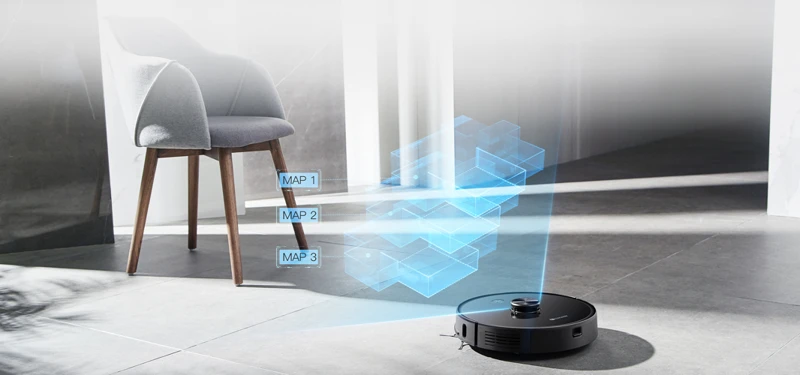
It’s time to say goodbye to the hassle of manual vacuuming and welcome a new era of revolutionary home cleaning – smart vacuum cleaners powered by navigation systems. These cutting-edge devices are equipped with advanced technology that enables them to navigate through your home with ease, cleaning your floors effortlessly. The navigation systems provide a range of benefits that take home cleaning to the next level, making the process more efficient and user-friendly. In this section, we’ll dive into the world of smart vacuums and explore the advantages of their navigation systems. Let’s explore the key features of these devices, from mapping and pathfinding to room recognition and more. You’ll discover why top smart vacuums with advanced navigation systems are gaining immense popularity, and you’ll get tips on how to make the most of these systems to clean your home like never before.
Mapping and Pathfinding
One of the most impressive features of smart vacuum cleaners is their mapping and pathfinding capabilities. With advanced navigation systems, they can create a detailed map of the home and navigate through it efficiently.
Mapping: Smart vacuums use sensors, cameras, and laser mapping technologies to create a personalized map of your home. This map is stored in the vacuum’s memory and can be updated as the cleaning progresses. Some advanced models can even recognize the different levels of your home and store maps for each floor.
Pathfinding: Once the map is created, the navigation system calculates the most efficient cleaning path for the vacuum to follow. This helps to ensure that the entire floor is cleaned thoroughly and no spots are missed. The pathfinding algorithm takes into account obstacles such as furniture and walls and adjusts the path accordingly.
However, there are some issues that can arise with smart vacuum navigation. For example, some models may struggle to navigate around cluttered areas, leading to incomplete cleaning. Additionally, some homes may have unique layouts or features that can confuse the vacuum’s mapping system.
To avoid these issues, it’s important to choose a smart vacuum with advanced navigation capabilities. Look for models that use multiple sensors and mapping technologies to create a reliable map of your home. Regularly updating the map and moving any potential obstacles out of the way can also help the vacuum navigate smoothly.
Mapping and pathfinding are major contributors to the impressive cleaning efficiency of smart vacuums. With their advanced navigation systems, smart vacuums can navigate through your home with ease and provide a thorough clean in less time. To learn more about the importance of navigation systems in smart vacuums, check out our article on advanced navigation systems in smart vacuums.
Adaptability to Home Layout Changes
One of the top features of smart vacuums with navigation systems is their ability to adapt to changes in the layout of your home. This means that if you decide to move furniture around or add new pieces to a room, the smart vacuum will be able to adjust its cleaning pattern to accommodate the changes.
This adaptability is made possible by the mapping technology used in the vacuum’s navigation system. The vacuum creates a map of your home that it uses to navigate and clean. If the layout of the room changes, the vacuum will re-scan the area and update its map accordingly.
This feature is especially useful for homeowners who frequently rearrange their furniture or have seasonal decorations that change the layout of their home throughout the year. With a smart vacuum that can adapt to these changes, cleaning your home becomes less of a hassle.
However, it’s important to note that not all smart vacuums have equal adaptability. Some may struggle with certain layouts or have difficulty navigating tight spaces. That’s why it’s important to research and choose a vacuum with strong navigation capabilities.
To ensure that your smart vacuum is able to adapt as well as possible, be sure to follow these navigation tips:
| Tips for Smart Vacuum Navigation: |
|---|
| 1. Keep floors clear: |
| Make sure your floors are free of clutter and obstacles to improve the vacuum’s navigation. |
| 2. Use virtual boundaries: |
| Set up virtual boundaries in the vacuum’s app to prevent it from getting stuck or lost in certain areas. |
| 3. Regularly update the map: |
| Re-scan your home periodically or when changes occur to ensure the vacuum’s map is up-to-date. |
| 4. Choose a vacuum with advanced navigation: |
| Select a vacuum with advanced navigation technology to improve mapping and adaptability. |
With these tips and a smart vacuum with strong navigation capabilities, you can revolutionize your home cleaning routine and enjoy a cleaner, more comfortable living space. For more information on the importance of smart vacuum mapping and navigation, visit /advanced-navigation-smart-vacuum/.
Room Recognition and Customization
Smart vacuums have revolutionized the way we clean our homes, and one impressive feature that sets them apart from traditional vacuum cleaners is their room recognition and customization capability. With the help of advanced navigation systems, smart vacuums can recognize and map out individual rooms, making cleaning more efficient and hassle-free.
Room Recognition
Using sensors and cameras, smart vacuums can recognize and map out individual rooms in a home. This technology allows the vacuum to differentiate between one room and another, ensuring that each room receives the attention it needs. Additionally, this feature makes it possible for the user to schedule cleaning times for individual rooms or even exclude certain rooms altogether.
Customization
With smart vacuums, users have the ability to customize the cleaning process for each room. Depending on the type of flooring in a particular room, the user can adjust the vacuum’s suction power accordingly. This customization ensures that the vacuum is cleaning each room as effectively as possible.
Another outstanding feature of smart vacuums is their ability to recognize obstacles and adjust their cleaning pattern accordingly. For example, if the vacuum encounters a pile of clutter or furniture that is blocking its path, it will map out a new cleaning route to avoid the obstacle. This results in more efficient cleaning, saving the user time and effort.
In addition to the aforementioned features, smart vacuums can also be programmed to clean on a regular basis, ensuring that your home is always clean and tidy. Users can create virtual boundaries to prevent the vacuum from entering certain areas or rooms.
Using a smart vacuum with room recognition and customization capabilities can drastically improve the efficiency and effectiveness of your cleaning routine. If you’re interested in learning more about smart vacuum navigation and the role it plays in home cleaning, check out our smart vacuum navigation guide.
Improving Cleaning Efficiency with Smart Vacuums
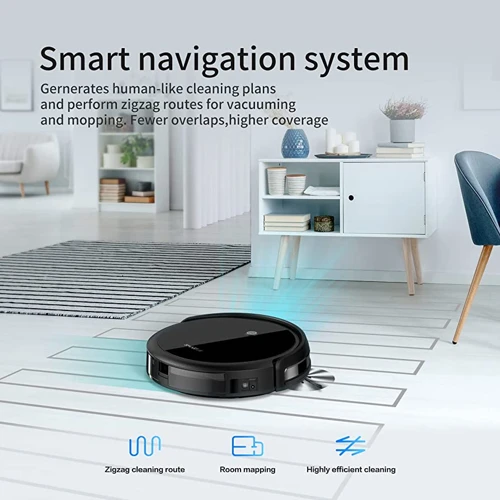
When it comes to cleaning, efficiency is key. You don’t want to spend hours vacuuming your home only to find spots you’ve missed or end up disrupting your entire day’s schedule. Luckily, with the introduction of smart vacuums powered by navigation systems, you can now get a more thorough and efficient clean. These vacuums come equipped with advanced technologies that enable them to clean better and faster, ultimately saving you time and effort. In this section, we’ll explore the different ways in which smart vacuums improve cleaning efficiency, including automated cleaning processes, virtual boundaries, and multi-room cleaning capabilities. Whether you’re dealing with pet hair, allergies, or just want to maintain a clean home, a smart vacuum with advanced navigation systems can be a game-changer. So, let’s dive in and explore the cutting-edge features that make these vacuums work so seamlessly. If you want to learn more about the importance of smart vacuum mapping, check out our article on importance of smart vacuum mapping.
Automated Cleaning Processes
Smart vacuum cleaners that are powered by navigation systems have revolutionized the way we clean our homes. With their advanced mapping and pathfinding capabilities, these gadgets can clean any room with minimal supervision. One of the most significant benefits that these vacuum cleaners offer is the ability to automate the cleaning process.
Below are some of the ways that smart vacuums can automate cleaning processes:
- Starting and stopping: Smart vacuums come with automated starting and stopping programming. Once the device is programmed, it will start and stop cleaning without any user intervention. This feature makes it possible for cleaning to take place when nobody is around to press any buttons.
- Recharging: Smart vacuums come with rechargeable batteries. These devices have sensors that help them return to their docking stations when their battery life runs low. Once they dock, they recharge, and then resume cleaning without any human intervention.
- Maintaining suction: Many smart vacuums come with sensors that monitor the suction power. The sensors help to maintain consistent suction power so that the device will pick up all the dirt and debris on the floor.
Smart vacuums with navigation systems offer several benefits, including saving time and energy. However, like any other technology, these devices are not entirely perfect, and navigation issues can arise that may prevent the vacuum from completing its task successfully. Users must learn tips on how to maximize their vacuum’s performance.
The next section will discuss the virtual boundaries and personalized scheduling features that smart vacuums offer to enhance cleaning efficiency.
Virtual Boundaries and Personalized Scheduling
One of the most convenient features of smart vacuums powered by navigation systems is the ability to set virtual boundaries for cleaning. Users can use their smartphone app to draw a virtual boundary around an area they don’t want the vacuum to clean. This is especially useful for those with pets or children who may leave toys or other objects on the floor that they don’t want the vacuum to accidentally suck up.
Another great feature is personalized scheduling. Users can set the vacuum to clean on certain days or at specific times, providing a more customizable cleaning experience. For those who prefer a more hands-off approach to cleaning, this feature is a game changer.
| Features | Explanation |
|---|---|
| Virtual Boundaries | Users can set boundaries around areas they don’t want the vacuum to clean. |
| Personalized Scheduling | Users can set the vacuum to clean at specific times or on certain days for a customized cleaning schedule. |
Smart vacuums with navigation systems are constantly evolving with new features that make cleaning even more effortless. To learn more about the top smart vacuums with navigation systems, check out our article on top smart vacuums with navigation systems or read our in-depth review of a smart vacuum with navigation capabilities.
Multi-Room Cleaning Capabilities
One of the most impressive features of smart vacuum cleaners is their multi-room cleaning capabilities. With traditional vacuums, you would have to physically carry the device to each room and manually clean it yourself. This process is not only time-consuming, but also exhausting. However, with the advanced navigation systems installed in smart vacuums, cleaning multiple rooms has never been easier.
Using mapping and pathfinding, these vacuums are able to create a digital floor plan of your home, making it easy for them to navigate from room to room without any assistance. Some models, such as the Roomba i7+, even have the ability to store multiple floor plans in their memory. This means that you can move the device to a different floor or an entirely new home, and the vacuum will still be able to navigate and clean without your help.
Another impressive feature of multi-room cleaning is the automated cleaning processes that these vacuums employ. You can set schedules for the device to automatically start cleaning at specific times, such as when you leave for work or when you are sleeping. This means that even if you are not physically present, the vacuum will still be able to clean your home and keep it spotless.
Smart vacuums come with virtual boundaries that allow you to customize the cleaning process for your home. You can set boundaries and zones that tell the vacuum where it can and cannot go. This means that if you have a room that you do not want the vacuum to enter, you can set a virtual boundary that will ensure it stays out.
Finally, multi-room cleaning also means that these devices are able to adapt to changes in your home layout. For example, if you rearrange your furniture or add a new room, the vacuum will be able to update its digital map and continue cleaning effectively.
All of these features work together to make smart vacuums an incredibly efficient and valuable home cleaning tool. With the ability to clean multiple rooms without assistance, set schedules to automatically start cleaning, and customize cleaning boundaries, these vacuums are revolutionizing the way we keep our homes clean.
The Future of Smart Vacuum Cleaners
The possibilities for smart vacuum cleaners are endless, as they continue to evolve and adapt with advancing technology. As we look ahead to the future of these devices, it’s clear that there are several exciting developments on the horizon. From seamless integration with other smart home devices to significant advancements in artificial intelligence and machine learning, our homes are set to receive an unprecedented level of customized and personalized cleaning. Let’s dive deeper and explore what the future has in store for smart vacuums.
Integration with Other Smart Home Devices
With the rise of smart home technology, it’s no surprise that smart vacuum cleaners are becoming more integrated with other devices in the home. These integrations allow for a seamless cleaning experience that can be tailored to fit the needs of the homeowner.
Device Integration
One of the most significant advantages of smart vacuums is their ability to integrate with other smart home devices. For example, some smart vacuums can be controlled through a mobile app, which means that homeowners can schedule cleanings or adjust the settings even when they’re not home. Additionally, some smart vacuums can be connected to virtual assistants such as Amazon Alexa or Google Assistant, giving homeowners the ability to control their vacuum using voice commands.
Interoperability
Smart vacuums that use an open API (Application Programming Interface) can be integrated with other smart home devices that are also compatible with the same API. This means that if a homeowner wants to create a “smart” cleaning routine that includes other smart devices, they can do so seamlessly. For example, a homeowner could program their smart vacuum to start cleaning after the smart thermostat detects that no one is home.
Seamless Functionality
When smart vacuum cleaners are integrated with other smart home devices, they operate seamlessly. For example, a homeowner could program their smart vacuum to stop cleaning when their smart security system is triggered. This type of integration allows for a more efficient and customized cleaning experience.
Smart Vacuum Integration Use Cases
Here are a few examples of how smart vacuum integration could be used to make home cleaning even easier:
| Integration | Possible Use Case |
|---|---|
| Smart Thermostat | Automatically turn on the vacuum when no one is home to make cleaning quicker and more efficient |
| Virtual Assistant | Control the vacuum using voice commands instead of reaching for a remote or mobile app |
| Smart Security System | Stop the vacuum when the security system is triggered to avoid vacuuming up unexpected items or areas |
As smart home technology continues to evolve, smart vacuum cleaners will become even more integrated with other devices in the home. This integration will lead to a more efficient and customized cleaning experience that can be tailored to fit the needs of homeowners.
Artificial Intelligence and Machine Learning Advancements
As the world of technology continues to evolve, advancements in artificial intelligence (AI) and machine learning are revolutionizing the home cleaning industry. Smart vacuums are becoming increasingly sophisticated, with the ability to learn from their surroundings and make decisions based on the data they collect.
AI and Machine Learning in Smart Vacuums
One of the greatest advantages of AI in smart vacuums is their ability to adapt to different cleaning environments. By using machine learning algorithms, these devices can analyze data from sensors to determine the layout of a room, the size of obstacles, and the best route to take for optimal cleaning efficiency.
Benefits of AI and Machine Learning-Powered Smart Vacuums
One key benefit of AI and machine learning advancements in smart vacuums is increased personalization. With the ability to learn from user behavior and preferences, these devices can customize cleaning schedules and routes to better suit the needs of individual users.
Another benefit is improved accuracy and effectiveness. By analyzing data and making real-time adjustments, AI-powered vacuums can provide a more thorough cleaning experience without the need for constant supervision.
Challenges and Limitations of AI in Smart Vacuums
Despite the potential benefits of AI in smart vacuums, there are also limitations to be considered. One challenge is the need for ongoing machine learning to ensure optimal efficiency and accuracy. Additionally, some users may have concerns about privacy and the collection of data by these devices.
The Future of AI and Machine Learning in Smart Vacuums
As AI and machine learning continue to evolve, the possibilities for smart vacuum technology are endless. In the future, we can expect to see even more advanced features and capabilities, such as the ability to communicate with other smart home devices and make even more accurate cleaning decisions based on real-time data.
The integration of AI and machine learning into smart vacuums is a promising development that is sure to revolutionize the home cleaning industry. As these devices continue to evolve and improve, we can look forward to a more personalized, efficient, and effective cleaning experience.
Increased Customization and Personalization
Smart vacuum cleaners powered by navigation systems have revolutionized home cleaning, offering unparalleled efficiency and convenience. However, the future of these devices is even more exciting as they move towards increased customization and personalization.
One way that smart vacuums will become more personalized is through the use of advanced sensors and software. These sensors will allow the vacuum to learn from its environment and adapt its cleaning settings to meet the specific needs of each room. For example, if a particular room has a lot of foot traffic or pet hair, the vacuum will automatically increase its suction power or adjust its cleaning pattern to ensure that the room is thoroughly cleaned.
Another way that smart vacuums will become more customizable is through the use of mobile apps. Vacuum manufacturers are already developing apps that allow users to control their device remotely and customize their cleaning settings based on their individual preferences. With these apps, users can set cleaning schedules, adjust cleaning modes, and define virtual boundaries to keep the vacuum away from certain areas of the home.
To provide more customization and personalization, manufacturers are also exploring the use of voice assistants, such as Amazon Alexa or Google Home, to control their vacuum cleaners. This feature will provide greater ease of use, allowing users to simply give voice commands to start or stop cleaning, adjust the suction power or change the cleaning mode.
To give a clearer picture of the advancements in customization and personalization of smart vacuum cleaners, refer to the table below:
| Features | Benefits |
|---|---|
| Advanced Sensors | Learn from the environment and adapt to the specific needs of each room to ensure thorough cleaning |
| Mobile Apps | Allows for remote control, customized cleaning settings, and scheduling with ease and convenience |
| Voice Assistants | Control the vacuum with simple voice commands, making it even easier to use and customize |
All in all, increased customization and personalization of smart vacuum cleaners will offer greater convenience, efficiency, and effectiveness, making home cleaning more effortless and stress-free than ever before.
The Bottom Line
It’s clear that smart vacuum cleaners powered by navigation systems have revolutionized the way we clean our homes. With their advanced mapping and pathfinding capabilities, these devices can efficiently navigate any home layout, adapt to changes, and recognize rooms for customized cleaning.
The convenience of automated cleaning processes, virtual boundaries, and personalized scheduling means homeowners can set it and forget it, allowing the smart vacuum cleaner to do the job without any additional work. And with multi-room cleaning capabilities, these devices can handle larger homes and apartments much more effectively than traditional vacuum cleaners.
Looking to the future, we can expect these devices to integrate even further with other smart home devices, offering a more seamless and integrated experience. Artificial intelligence and machine learning advancements will improve the accuracy of mapping and cleaning, while increased customization and personalization options will ensure that these devices meet the specific needs of each home and homeowner.
The benefits of smart vacuum cleaners powered by navigation systems are clear. They save time, increase efficiency, and ultimately make our lives easier. As the technology continues to evolve and improve, we can only expect more exciting developments and innovations in the world of home cleaning.
Frequently Asked Questions
What is a smart vacuum cleaner?
A smart vacuum cleaner is a robotic vacuum that uses advanced technologies like navigation systems, sensors, and mapping to clean floors autonomously.
How do smart vacuums navigate around a home?
Smart vacuums use a variety of navigation technologies, including lidar, radar, and optical sensors, to map out the home and navigate around obstacles.
Do smart vacuums have the ability to clean multiple rooms?
Yes, many smart vacuums are capable of cleaning multiple rooms. They can be programmed to clean specific areas, or they may be able to detect and navigate between rooms on their own.
Are smart vacuums more efficient at cleaning than traditional vacuums?
Smart vacuums can be more efficient than traditional vacuums because they use advanced technologies to map out the home and clean floors autonomously. This means they are less likely to miss spots and can clean more efficiently.
What is room recognition technology, and how does it work?
Room recognition technology allows smart vacuums to detect and navigate between different rooms in a home. It usually relies on sensors and mapping technologies to identify different spaces and adapt cleaning patterns accordingly.
Can smart vacuums adapt to changes in a home’s layout?
Yes, many smart vacuums are designed to adapt to changes in a home’s layout. They may use mapping technologies to constantly update their understanding of the home’s layout and adjust their cleaning patterns accordingly.
Do smart vacuums have virtual boundary capabilities?
Yes, many smart vacuums have virtual boundary capabilities. This allows users to set boundaries for the vacuum, telling it which areas to avoid or clean.
Can smart vacuums be programmed for personalized scheduling?
Yes, many smart vacuums can be programmed for personalized scheduling. This allows users to set specific times for the vacuum to clean, as well as customize cleaning patterns for different days or times of the week.
What is the future of smart vacuum technology?
The future of smart vacuum technology is likely to involve further advancements in machine learning and artificial intelligence, allowing vacuums to adapt to homeowners’ preferences in even more customized ways. They may also be able to integrate with other smart home devices to make cleaning even more seamless and efficient.
Are smart vacuums worth the investment?
Smart vacuums can be a worthwhile investment for those who value the convenience and efficiency of autonomous cleaning. While they can be more expensive than traditional vacuums, their advanced technologies and customizable features may make them a worthwhile purchase for many homeowners.

